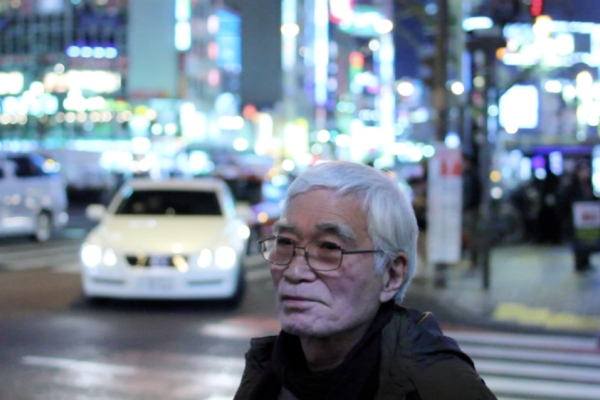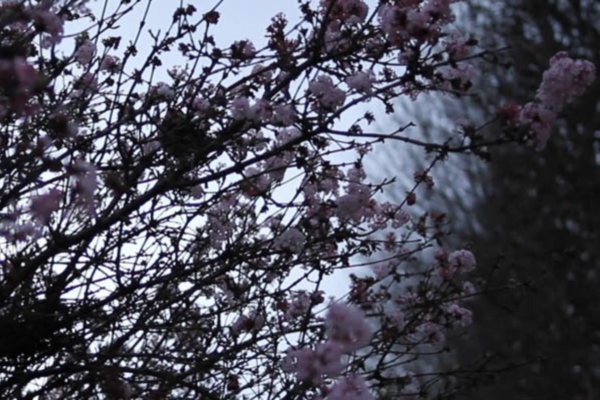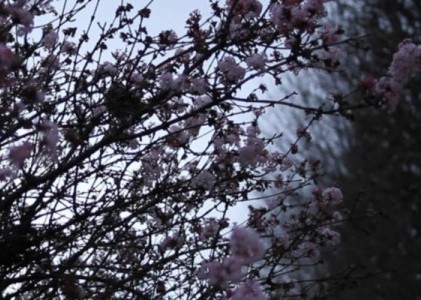Darkness Doubled
To start the New Year, the Museum introduces First Look, a new annual showcase curated by Dennis Lim, Rachael Rakes, and David Schwartz. This two-weekend program—which brings together some of the most invigorating and inventive voices in contemporary world cinema, including established and emerging filmmakers—affirms our belief in cinema as a flourishing art form. To supplement the program, Moving Image Source is running a series of essays on all the feature films that are being shown. Check back daily from now through next weekend for new articles.
In 2000, after nearly three decades in self-imposed exile, Masao Adachi was arrested in Lebanon and extradited to his native Japan. Since 1971, Adachi had served as a member of the militant-communist Japanese Red Army in the Middle East, but prior to that he was better known for his work in film. An important figure in 1960s Japanese experimental cinema for provocative, surrealistic short films like Closed Vagina and Galaxy, he was also a screenwriter for Nagisa Oshima and especially Koji Wakamatsu. For Wakamatsu Productions, Adachi scripted dozens of films, many of them of the adult pinku-eiga genre (with titles like Violated Angels, Go, Go Second Time Virgin, Gushing Prayer, and Ecstasy of the Angels), but soon his work took on a more political bent. High School Guerrilla (1969) marries sexploitation with radical politics, while subsequent work became increasingly polemical, like the experimental true-crime landscape film AKA Serial Killer (1969), which seems to anticipate Chantal Akerman's News From Home and the work of James Benning, and his 1971 disquisition on propaganda and the Palestinian struggle, Red Army/PFLP: Declaration of World War.
Adachi didn't return to filmmaking until 2007's Prisoner/Terrorist, a fictionalized account of fellow JRA member Kozo Okamato. His own life could probably be the subject of such a biopic, but French filmmaker Philippe Grandrieux has chosen to make his film about Adachi more of an encounter than a portrait, an intimate meeting of minds and artistic and political sensibilities. Cinematic re-creations of the 1970s radical left are very much en vogue nowadays, but rather than offer up the stylish, gossipy pleasures of Olivier Assayas's Carlos, Uli Edel's The Baader-Meinhof Complex, or even Wakamatsu's own United Red Army, Grandrieux opts for something more mysterious, an almost ghostly mood piece that privileges impressionism and doubt over the forced coherence of history.

Masao Adachi in It May Be That Beauty Has Strengthened Our Resolve: Masao Adachi
This pursuit of the vagaries of perception is of a piece with Grandrieux's other work, which remains too little seen in North America. Aside from a number of experimental essay films, video-art pieces, and a Marilyn Manson video, Grandrieux's career comprises three features, often shot and edited by the director himself: a gut-wrenching, largely sonic horror movie (Sombre), a scabrous and off-kilter Eastern European sex-trafficking story (La Vie nouvelle), and a hushed, wintry fairy tale (Un Lac). Eschewing narrative, characterization, and all other means of convention and certitude, each of these films pushes the boundaries of cinema's purely photographic capabilities, with images that seem to shudder and swoon, perched precipitously at the limits of the visible. (Rumor has it that Grandrieux even tried to have the exit signs covered up at festival screenings of Un Lac, the better to envelop the audience in that film's exquisitely sustained form of sensory deprivation.) Overexposed to the point of blown-out indistinctness, thrown wildly out of focus, or stopped down to almost complete blackness, the images in Grandrieux's work testify to a kind of ecstasy of perception, a groping, epileptic vision that finds some correlate in the work of Stan Brakhage and David Lynch.
In It May Be That Beauty Has Strengthened Our Resolve: Masao Adachi, winner of the New:Vision Award at last year's CPH:DOX festival in Copenhagen, Grandrieux brings this rapturous gaze to documentary, opening his film with an extended take of Adachi playing on swings with his granddaughter, their faces barely discernible, with only tiny glimpses of traffic lights, the child's pink coat, and Adachi's mop of white hair to pierce the fuzzy blue-black twilight. In voiceover, Adachi whispers of desires, intentions, hungers, points of origin, impressions: of his mother, who indoctrinated him with resistance to the American occupation of Japan when he was a child; of language and its deceptions; of Marxist dialectic; of incomprehensible images and memories. "One only uses memories to imagine," he murmurs. "Revolution, that's an image, too. The problem is how to make the image real."
Through many such enshrouded images of Adachi, Grandrieux forms a fragmentary image of Adachi's worldview—what Adachi himself calls "a collection of thoughts [that] superimpose themselves ... juxtapose themselves or coalesce to establish an idea of the world." But the film also sketches a pointillist image of the city of Tokyo as Grandrieux's camera wanders amid floods of people and neon light. Much like Adachi's AKA Serial Killer, which narrates the story of the notorious Norio Nagayama's killing spree minimalistically through after-the-fact images of the crime-scenes, Grandrieux's film operates under Adachi's application of fukei-ron, or Japanese Landscape Theory, which evokes the ways in which identity and environment are bound together with forms of social control. And just as Adachi's film contrasted its images with free-jazz improvisations, Grandrieux's finds counterpoint in a diverse ambient soundtrack of chiming electronic keyboards, skittering shards of noise, and unexpected bursts of guitar.

It May Be That Beauty Has Strengthened Our Resolve: Masao Adachi
As Grandrieux ruminates on Adachi and the city of Tokyo, he channels other filmmakers and artists, as well. Adachi's recollection of reading André Breton at an impressionable age spurs his neo-Dadaist assertion that "It was enough to broach the subject of reality, even if I didn't understand it"; his anecdote about encountering Jean Genet in Beirut in the 1970s calls up the memory of reading Genet's The Thief's Journal aloud with Oshima while writing The Diary of a Shinjuku Thief; Grandrieux's drive through Tokyo's expressways leads him back to Tarkovsky's Solaris, but also tacitly invokes Chris Marker's Sans soleil, another collage of tourist visions siphoned through a kind of Marxist surrealism. In this way, the film becomes as much a transference of ideas and energies between artists as it is an attempt to capture a particular artist's worldview in any stable or coherent way: "Cinema moves from one film to another through time, above and beyond those who make it."
Ultimately, as the film's aphoristic title suggests, It May Be That Beauty Has Strengthened Our Resolve is less interested in biography than in the problem of integrating politics and art, or more precisely of finding new ways of looking at the world that will alter it both socially and aesthetically. For Grandrieux, Adachi becomes a heroic figure not merely as a provocateur and outlaw, but also as one for whom the border between the physical and mental world, the realms of life and art, must always remain productively ambiguous. "Making movies seemed contradictory to guerrilla warfare," Adachi recalls. "But I told myself that it was for me to resolve this issue." Through his own transformative vision, Grandrieux similarly blurs distinctions and revels in the gray, nebulous middle zones. For both filmmakers, as Adachi puts it, "Revolution means 'I don't understand.'" ![]()
LATEST ARTICLES
-20140814-173707-thumb3.jpg)
Fighting Words
by Imogen Sara Smith
posted August 12, 2014

Fighting Words, Part 2
by Imogen Sara Smith
posted August 20, 2014

On the Margins: The Fil…
by Andrew Chan
posted August 12, 2014

Robin Williams: A Sense…
by David Schwartz
posted August 12, 2014
 Darkness Doubled
Darkness Doubled
KEYWORDS
First Look | Masao Adachi | documentary | Philippe Grandrieux | film review | political film | It May Be That Beauty Has Strengthened Our Resolve: Masao AdachiRELATED ARTICLE
Jungle Fever by Andréa PicardGoing the Distance by Scott MacDonald
Glass Houses by Michael Sicinski
Island Time by R. Emmet Sweeney
Ghost World by Colin Beckett
Unplugged by Phil Coldiron
A Nude by Garrel by Eugenio Renzi
Twilight Zone by Robert Koehler
Family Viewing by Mark Peranson
Capitalist Punishment by Shelly Kraicer
Her Own Devices by Robert Koehler
The Fallen by Phil Coldiron
The 1 Percent Solution by Michael Sicinski
Cultural Guerrillas by Nicole Brenez and Philippe Grandrieux
More: Article Archive
THE AUTHOR
Leo Goldsmith co-edits the film section of The Brooklyn Rail and is a PhD candidate in the Department of Cinema Studies at New York University. He contributes regularly to Not Coming to a Theater Near You and Reverse Shot.
More articles by Leo GoldsmithAuthor's Website: Not Coming to a Theater Near You

